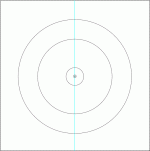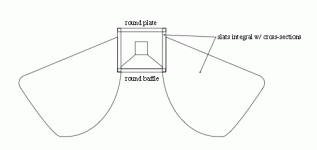PMA said:I would not equalize that much. There are pretty big differences between different sound systems. And horns are especially uncapable to play complex music.
Why do you say that?
se
Steve Eddy said:
Hehehe.
Yeah, soon as I saw them I started thinking about ripping the fireplace out of the living room and building one of those into the wall and going mono a la Sakuma. 🙂
se
now you're talkin' my language!! i've actually had a mono setup for the past 2 years (up until recently). of course...there have been any number of rotating "systems"...but i went through a big mono kick!!
i have a new "design" that's a combo front/back horn that mounts on a wall (in the center), and uses the ceiling/floor/side walls much like a corner horn would. it is round (or some sort of polygon w/ many sides) and looks almost like a flower (with the driver in the middle). i figured...why not use the whole room as a horn ;-) it would probably only work in a square-ish setting. of course...it is a rough design not based on horn calculations just yet...more to get the idea down. i've attached some screenshots of the "design". just mount that sucker up on your wall and violá!
Attachments
And horns are especially uncapable to play complex music.
a friend and me did some listening on our different speakers (2way closed, 2way compound, A7 + the horn on the left) with exactly that music, symphonie fanatstique, and our finding was the opposite: with Berlioz my horns were the best.
enochRoot said:and a cross section...
Thanks. When I looked at the first one, I couldn't help thinking "You know. For kids!" (for those who've seen the film The Hudsucker Proxy) 😀
Looks like you're off to a good start. I'm afraid I don't have a free wall to do something like that unless I remove a rather large brick fireplace. Oh well. Someday perhaps. 🙂
I guess I could just get one of the Fostex 31" woofers and mount it in the wall and use the other room as a very large infinite baffle enclosure. 🙂
se
till said:a friend and me did some listening on our different speakers (2way closed, 2way compound, A7 + the horn on the left) with exactly that music, symphonie fanatstique, and our finding was the opposite: with Berlioz my horns were the best.
That one of Bruce's horns?
se
That one of Bruce's horns?
no its a selfmade horn. But before i made it i had some emails with Mr. Edgar concerning his saladbowls, and mine is also a tractrix. So its a relative of his horns.
http://home.tu-clausthal.de/~tpa/VotT/IMAGE0148.JPG
till said:no its a selfmade horn. But before i made it i had some emails with Mr. Edgar concerning his saladbowls, and mine is also a tractrix. So its a relative of his horns.
http://home.tu-clausthal.de/~tpa/VotT/IMAGE0148.JPG
Nice!
What's the cutoff on those? Been thinking of having some 300 Hz wood horns made.
se
i don´t know the exactly cuttoff, but they are a little small for 300Hz. For more information look into this old thread:
http://www.diyaudio.com/forums/showthread.php?s=&threadid=7032&perpage=10&highlight=&pagenumber=1
i still hope to find time to make some more (and larger) of these horns.
http://www.diyaudio.com/forums/showthread.php?s=&threadid=7032&perpage=10&highlight=&pagenumber=1
i still hope to find time to make some more (and larger) of these horns.
till said:i don´t know the exactly cuttoff, but they are a little small for 300Hz. For more information look into this old thread:
http://www.diyaudio.com/forums/showthread.php?s=&threadid=7032&perpage=10&highlight=&pagenumber=1
i still hope to find time to make some more (and larger) of these horns.
Thanks!
se
White Paper
Hello NP,
waiting for the white paper! Is it available soon? Is there enough info to build such an amplifier?
Regards,
Reinhard
Hello NP,
waiting for the white paper! Is it available soon? Is there enough info to build such an amplifier?
Regards,
Reinhard
The first white paper is a discussion of using current source
amplifiers with full-range high-efficiency drivers, and is done.
Mr. Harrington will begin posting files tomorrow. 😎
amplifiers with full-range high-efficiency drivers, and is done.
Mr. Harrington will begin posting files tomorrow. 😎
To me it looks like Mr. Harrington has to work on it again: pioneer_bu20f20-51f.PDF shows me somthing about the Jordan J92S
fostex_ff225k.PDF has similar content as fostex_ff165k.PDF
i can´t find the difference in fostex_fe166e.PDF and fostex_fe166e_abbey.PDF at the momen, they both seem to show the 07. cubic feet enclosure.
else: very interesting, more of this please!
fostex_ff225k.PDF has similar content as fostex_ff165k.PDF
i can´t find the difference in fostex_fe166e.PDF and fostex_fe166e_abbey.PDF at the momen, they both seem to show the 07. cubic feet enclosure.
else: very interesting, more of this please!
yeah...noticed that. but if you download the pdf...it's fine. the error was just when it was ported to the web 😉
I found an article of the FirstWatt product and info on full range speakers:
http://www.6moons.com/audioreviews/firstwatt/firstwatt.html
and it looks like the F1 will be sold here:
http://www.renohifi.com/first_watt.html
with an MSRP of $2500
--
Brian
http://www.6moons.com/audioreviews/firstwatt/firstwatt.html
and it looks like the F1 will be sold here:
http://www.renohifi.com/first_watt.html
with an MSRP of $2500
--
Brian
Just got thinking...
One watt into 8 ohms represents about 350 milliamps of current. Which means that for 1 watt, a voltage source amplifier will be applying 2.83 volts across the load and an equivalent current source amplifier will be shoving 350 milliamps through the load.
And if a voltage source amplifier outputs 2.83 volts for a given input voltage, the equivalent current source amplifier will output 350 milliamps for that same given input voltage.
Using the Fostex FE108E as an example, its impedance is at 8 ohms at 400 Hz. So if a voltage source amplifier is applying 2.83 volts at 400 Hz, we'll get 1 watt. Similarly, an equivalent current source amplifier will be shoving 350 milliamps through the voice coil and we'll also get 1 watt.
But at the FE108E's resonant frequency in the .4 cubic foot box used for the tests in the white paper (at 90 Hz), the FE108E's impedance is 90 ohms.
So with the same input signal, at 90 Hz, the current source amplifier will still want to output 350 milliamps. With a load impedance of 90 ohms, that comes to a little over 30 watts that the voice coil has to dissipate compared to just over 30 milliwatts for a voltage source amplifier.
Seems to me that a driver fed from a current source amplifier will run a hell of a lot hotter compared to being driven from a voltage source amplifier. Though I suppose the increased resistance of the voice coil due to the heating wouldn't result in the same sort of thermal compression you'd get if you were running that same amount of power into it with a voltage source amplifier.
But the F1 is rated at 10 watts, which I presume is into 8 ohms. How would it be able to deliver 1 watt into something like the FE108E at 400 Hz while also delivering over 30 watts at 90 Hz?
se
One watt into 8 ohms represents about 350 milliamps of current. Which means that for 1 watt, a voltage source amplifier will be applying 2.83 volts across the load and an equivalent current source amplifier will be shoving 350 milliamps through the load.
And if a voltage source amplifier outputs 2.83 volts for a given input voltage, the equivalent current source amplifier will output 350 milliamps for that same given input voltage.
Using the Fostex FE108E as an example, its impedance is at 8 ohms at 400 Hz. So if a voltage source amplifier is applying 2.83 volts at 400 Hz, we'll get 1 watt. Similarly, an equivalent current source amplifier will be shoving 350 milliamps through the voice coil and we'll also get 1 watt.
But at the FE108E's resonant frequency in the .4 cubic foot box used for the tests in the white paper (at 90 Hz), the FE108E's impedance is 90 ohms.
So with the same input signal, at 90 Hz, the current source amplifier will still want to output 350 milliamps. With a load impedance of 90 ohms, that comes to a little over 30 watts that the voice coil has to dissipate compared to just over 30 milliwatts for a voltage source amplifier.
Seems to me that a driver fed from a current source amplifier will run a hell of a lot hotter compared to being driven from a voltage source amplifier. Though I suppose the increased resistance of the voice coil due to the heating wouldn't result in the same sort of thermal compression you'd get if you were running that same amount of power into it with a voltage source amplifier.
But the F1 is rated at 10 watts, which I presume is into 8 ohms. How would it be able to deliver 1 watt into something like the FE108E at 400 Hz while also delivering over 30 watts at 90 Hz?
se
- Status
- Not open for further replies.
- Home
- Amplifiers
- Pass Labs
- Any new news on FirstWatt??

